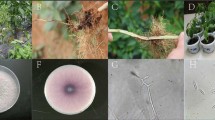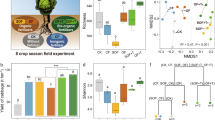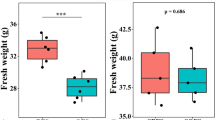Abstract
Bio-fertilizer application has been proposed as a strategy for enhancing soil fertility, regulating soil microflora composition, and improving crop yields, and it has been widely applied in the agricultural yields. However, the application of bio-fertilizer in grassland has been poorly studied. We conducted in situ and pot experiments to investigate the practical effects of different fertilization regimes on Leymus chinensis growth, with a focus on the potential microecological mechanisms underlying the responses of soil microbial composition. L. chinensis biomass was significantly (P < 0.05) increased by treatment with 6000 kg ha−1 of Trichoderma bio-fertilizer compared with other treatments. We found a positive (R2 = 0.6274, P < 0.001) correlation between bacterial alpha diversity and L. chinensis biomass. Hierarchical cluster analysis and nonmetric multidimensional scaling (NMDS) revealed that soil bacterial and fungal community compositions were all separated according to the fertilization regime used. The relative abundance of the most beneficial genera in bio-fertilizer (BOF) (6000 kg ha−1Trichoderma bio-fertilizer) was significantly higher than in organic fertilizer (OF) (6000 kg ha−1 organic fertilizer) or in CK (non-amend fertilizer), there the potential pathogenic genera were reduced. There were significant negative (P < 0.05) correlations between L. chinensis biomass and the relative abundance of several potential pathogenic genera. However, the relative abundance of most beneficial genera were significantly (P < 0.05) positively correlated with L. chinensis biomass. Soil properties had different effects on these beneficial and on these pathogenic genera, further influencing L. chinensis biomass.







Similar content being viewed by others
References
Abawi GS, Widmer TL (2000) Impact of soil health management practices on soil-borne pathogens, nematodes and root diseases of vegetable crops. Appl Soil Ecol 15:37–47
Acosta-Martinez V, Dowd S, Sun Y, Allen V (2008) Tag-encoded pyrosequencing analysis of bacterial diversity in a single soil type as affected by management and land use. Soil Biol Biochem 40:2762–2770
Amend AS, Seifert KA, Bruns TD (2010) Quantifying microbial communities with 454 pyrosequencing: does read abundance count? Mol Ecol 19:5555–5565
Bell T, Newman JA, Silverman BW, Turner SL, Lilley AK (2005) The contribution of species richness and composition to bacterial services. Nature 436:1157–1160
Bending GD, Turner MK, Rayns F, Marx MC, Wood M (2004) Microbial and biochemical soil quality indicators and their potential for differentiating areas under contrasting agricultural management regimes. Soil Biol Biochem 36:1785–1792
Bronick CJ, Lal R (2005) Soil structure and management: a review. Geoderma 124:3–22
Buée M, Reich M, Murat C, Morin E, Nilsson RH, Uroz S, Martin F (2009) 454 pyrosequencing analyses of forest soils reveal an unexpectedly high fungal diversity. New Phytol 184:449–456
Bünemann EK, Schwenke GD, Van Zwieten L (2006) Impact of agricultural inputs on soil organisms- a review. Soil Res 44:379–406
Cai F, Chen W, Wei Z, Pang G, Li RX, Ran W, Shen QR (2015) Colonization of Trichoderma harzianum strain SQR-T037 on tomato roots and its relationship to plant growth, nutrient availability and soil microflora. Plant Soil 388:337–350
Cao Y, Zhang ZH, Ling N, Yuan YJ, Zheng XY, Shen B, Shen QR (2011) Bacillus subtilis SQR 9 can control fusarium wilt of cucumber by colonizing plant roots. Biol Fertil Soils 47:495–506
Caporaso JG, Lauber CL, Walters WA, Berg-Lyons D, Lozupone CA, Turnbaugh PJ, Fierer N, Knight R (2011) Global patterns of 16S rRNA diversity at a depth of millions of sequences per sample. Proc Natl Acad Sci U S A 108:4516–4522
Cardinale BJ, Srivastava DS, Duffy JE, Wright JP, Downing AL, Sankaran M, Jouseau C (2006) Effects of biodiversity on the functioning of trophic groups and ecosystems. Nature 443:989–992
Chaer G, Fernandes M, Myrold D, Bottomley P (2009) Comparative resistance and resilience of soil microbial communities and enzyme activities in adjacent native forest and agricultural soils. Microb Ecol 58:414–424
Chandanie WA, Kubota M, Hyakumachi M (2009) Interactions between the arbuscular mycorrhizal fungus Glomus mosseae and plant growth-promoting fungi and their significance for enhancing plant growth and suppressing damping-off of cucumber (Cucumis sativus L.). Appl Soil Ecol 41:336–341
Chen C, Zhang J, Lu M, Qin C, Chen Y, Yang L, Huang Q, Wang J, Shen Z, Shen Q (2016) Microbial communities of an arable soil treated for 8 years with organic and inorganic fertilizers. Biol Fertil Soils 52:455–467
De Souza JT, Bailey BA, Pomella AWV, Erbe EF, Murphy CA, Bae H, Hebbar PK (2008) Colonization of cacao seedlings by Trichoderma stromaticuma mycoparasite of the witches’ broom pathogen, and its influence on plant growth and resistance. Biol Control 46:36–45
Degrass G, Aguilar C, Bosco M, Zahariev S, Pongor S, Venturi V (2002) Plant growth-promoting Pseudomonas putida WC358 produces and secretes four cyclic dipeptides: cross-talk with quorum sensing bacterial sensors. Curr Microbiol 45:250–254
Edgar RC (2013) UPARSE: highly accurate OTU sequences from microbial amplicon reads. Nat Methods 10:996–998
Gachomo EW, Kotchoni SO (2008) The use of Trichoderma harzianum and T. viride as potential biocontrol agents against peanut microflora and their effectiveness in reducing aflatoxin contamination of infected kernels. Biotechnology 7:439–447
Gu YA, Wei Z, Wang XQ, Friman VP, Huang JF, Wang XF, Mei XL, Xu YC, Shen QR (2016) Jousset a (2016) pathogen invasion indirectly changes the composition of soil microbiome via shifts in root exudation profile. Biol Fertil Soils 52:997–1005
Harman GE, Howell CR, Viterbo A, Chet I, Lorito M (2004) Trichoderma species- opportunistic, avirulent plant symbionts. Nat Rev Microbiol 2:43–56
Hexon ACC, Lourdes MR, Carlos CP, Jose LB (2009) Trichoderma virens, a plant beneficial fungus, enhances biomass production and promotes lateral root growth through and auxin-dependent mechanism in Arabidopsis. Plant Physiol 149:1579–1592
Hollister EB, Hu P, Wang AS, Hons FM, Gentry TJ (2013) Differential impacts of brassicaceous and nonbrassicaceous oilseed meals on soil bacterial and fungal communities. FEMS Microbiol Ecol 83:632–641
Huang XQ, Chen LH, Ran W, Shen QR, Yang XM (2011) Trichoderma harzianum strain SQR-T37 and its bio-organic fertilizer could control Rhizoctonia solani damping-off disease in cucumber seedlings mainly by the mycoparasitism. Appl Microbiol Biotechnol 91:741–755
Insam H, Gómez-Brandón M, Ascher J (2015) Manure-based biogas fermentation residues-friend or foe of soil fertility? Soil Biol Biochem 84:1–14
IUSS Working Group WRB (2015) World Reference Base for soil resources 2014, update 2015. International soil classification system for naming soils and creating legends for soil maps. World soil resources reports no. 106. FAO, Rome
Jannoura R, Joergensen RG, Bruns C (2014) Organic fertilizer effects on growth, crop yield, and soil microbial biomass indices in sole and intercropped peas and oats under organic farming conditions. Eur J Agron Part B 52:259–270
Ju X, Xing G, Chen X, Zhang S, Zhang L, Liu X, Cui Z, Yin B, Christie P, Zhu Z, Zhang F (2009) Reducing environmental risk by improving N management in intensive Chinese agricultural systems. Proc Natl Acad Sci U S A 106:3041–3046
Kennedy A, Smith K (1995) Soil microbial diversity and the sustainability of agricultural soils. Plant Soil 170:75–86
Khaliq A, Abbasi MK, Hussain T (2006) Effects of integrated use of organic and inorganic nutrient sources with effective microorganisms (EM) on seed cotton yield in Pakistan. Bioresour Technol 97:967–972
Knudsen D, Peterson G, Pratt P (1982) Lithium, sodium, and potassium. In: Page AL, Miller RH, Kenney DR (eds) Methods of soil analysis, part 2, chemical and microbiological properties. American Society of Agronomy, soil science Society of American, Madison, pp 225–246
Kõljalg U, Nilsson RH, Abarenko K, Tedersoo L, Taylor AFS, Bahram M, Bates ST, Bruns TD, Bengtsson-Palme J, Callaghan TM, Douglas B, Drenkhan T, Eberhardt U, Dueñas M, Grebenc T, Griffith GW, Hartmann M, Kirk PM, Kohout P, Larsson E, Lindahl BD, Lücking R, Martín MP, Matheny PB, Nguyen NH, Niskanen T, Oja J, Peay KG, Peintner U, Peterson M, Põldmaa K, Saag L, Saar I, Schüßler A, Scott JA, Senés C, SmithME, Suija A, Taylor DL, Telleria MT, Weiss M, Larsson KH (2013) Towards a unified paradigm for sequence-based identification of fungi. Mol Ecol 22:5271–5277
Ladha JK, Khind CS, Gupta RK, Meelu OP, Pasuquin E (2004) Long-term effects of organic inputs on yield and soil fertility in the rice-wheat rotation. Soil Sci Soc Am J 68:845–853
Lim YW, Kim BK, Kim C, Jung HS, Kim BS, Lee JH, Chun J (2010) Assessment of soil fungal communities using pyrosequencing. J Microbiol 48:284–289
Liu X, Zhang J, Gu T, Zhang W, Shen Q, Yin S, Qiu H (2014) Microbial community diversities and taxa abundances in soils along a seven-year gradient of potato monoculture using high throughput pyrosequencing approach. PLoS One 9:e86610
Lopez-Mondejar R, Anton A, Raidl S, Ros M, Antonio Pascual J (2010) Quantification of the biocontrol agent Trichoderma harzianum with real-time TaqMan PCR and its potential extrapolation to the hyphal biomass. Bioresour Technol 101:2888–2891
Masunaka A, Hyakumachi M, Takenaka S (2011) Plant growth-promoting fungus, Trichoderma koningi suppresses isoflavonoid phytoalexin vestitol production for colonization on/in the roots of Lotus japonicus. Microbes Environ 26:128–134
Moral R, Paredes C, Bustamante MA, Marhuenda-Egea F, Bernal MP (2009) Utilisation of manure composts by high-value crops: safety and environmental challenges. Bioresour Technol 100:5454–5460
Naeem S, Li S (1997) Biodiversity enhances ecosystem reliability. Nature 390:507–509
Oksanen J, Kindt R, Legendre P, O’Hara B, et al (2009) Vegan: community ecology package. R. Package. Version 1.15–2
Olsen SR, Sommers LE (1982) Phosphorous. In: Page AL, Miller RH, Keeney DR (eds) Methods of Soil Analysis, Part 2. Agronomy 9, 2nd edn. American Society of Agronomy, Madison, pp 403–430
Qiu M, Zhang R, Xue C, Zhang S, Li S, Zhang N, Shen Q (2012) Application of bio-organic fertilizer can control fusarium wilt of cucumber plants by regulating microbial community of rhizosphere soil. Biol Fertil Soils 48:807–816
Raaijmakers JM, Paulitz TC, Steinberg C, Alabouvette C, Moenne-Loccoz Y (2009) The rhizosphere: a playground and battlefield for soil borne pathogens and beneficial microorganisms. Plant Soil 321:341–361
Roggenbuck M, Schnell IB, Blom N, Balum J, Bertelsen MF, Sicheritz-Ponten T, Sorensen SJ, Gilbert MTP, Graves GR, Hansen LH (2014) The microbiome of new world vultures. Nat Commun 5:5498
Schloss PD, Westcott SL, Ryabin T, Hall JR, Hartmann M, Hollister EB, Lesniewski RA, Oakley BB, Parks DH, Robinson CJ (2009) Introducing mothur: open-source, platform-independent, community-supported software for describing and comparing microbial communities. Appl Environ Microbiol 75:7537–7541
Scholer A, Jacquiod S, Vestergaard G, Schulz S, Schloter M (2017) Analysis of soil microbial communities based on amplicon sequencing of marker genes. Biol Fertil Soils 53:485–489
Singh BK, Campbell CD, Sorenson SJ, Zhou J (2009) Soil genomics. Nat Rev Microbiol 7:756–756
Smalla K, Wieland G, Buchner A, Zock A, Parzy J, Kaiser S, Roskot N, Heuer H, Berg G (2001) Bulk and rhizosphere soil bacterial communities studied by denaturing gradient gel electrophoresis: plant-dependent enrichment and seasonal shifts revealed. Appl Environ Microbiol 67:4742–4751
Sun RB, Zhang XX, Guo XS, Wang DZ, Chu HY (2015) Bacterial diversity in soils subjected to long-term chemical fertilization can be more stably maintained with the addition of livestock manure than wheat straw. Soil Biol Biochem 88:9–18
Tang Z, Yu GH, Liu DY, Xu DB, Shen QR (2011) Different analysis techniques for fluorescence excitation-emission matrix spectroscopy to assess compost maturity. Chemosphere 82:1202–1208
Toju H, Tanabe AS, Yamamoto S, Sato H (2012) High-coverage ITS primers for the DNA-based identification of ascomycetes and basidiomycetes in environmental samples. PLoS One 7(7):e40863
Vázquez MM, César S, Azcón R, Barea JM (2000) Interactions between arbuscular mycorrhizal fungi and other microbial inoculants (Azospirillum, Pseudomonas, Trichoderma) and their effects on microbial population and enzyme activities in the rhizosphere of maize plants. Appl Soil Ecol 15:261–272
Vestergaard G, Schulz S, Scholer A, Schloter M (2017) Making big data smart--how to use metagenomics to understand soil quality. Biol Fertil Soils 53(5):479–484
Wang Q, Garrity GM, Tiedje JM, Cole JR (2007) Naïve Bayesian classifier for rapid assignment of rRNA sequences into the new bacterial taxonomy. Appl Environ Microb 73, 5261–5267
Washington H (1984) Diversity, biotic and similarity indices: a review with special relevance to aquatic ecosystems. Water Res 18:653–694
Watanabe FS, Olsen SR (1965) Test of an ascorbic acid method for determining phosphorus in water and NaHCO3 extracts from soil. Soil Sci Soc Am J 22:677–678
Xiong W, Zhao QY, Zhao J, Xun WB, Li R, Zhang RF, Wu HS, Shen QR (2015) Different continuous cropping spans significantly affect microbial community membership and structure in a vanilla-grown soil as revealed by deep pyrosequencing. Microb Ecol 70:209–218
Yang YR, Li XG, Liu JG, Zhou ZG, Zhang TL, Wang XX (2017) Bacterial diversity as affected by application of manure in red soils of subtropical China. Biol Fertil Soils 53:639–649
Ye SF, Yu JQ, Peng YH, Zheng JH, Zou LY (2004) Incidence of fusarium wilt in Cucumis sativus L. is promoted by cinnamic acid an autotoxin in root exudates. Plant Soil 263:143–150
Zhang ZG, Zhang JY, Wang YC, Zheng XB (2005) Molecular detection of Fusarium oxysporum f. Sp. niveum and Mycosphaerella melonis in infected plant tissues and soil. FEMS Microbiol Lett 249:39–47
Zhang FG, Yuan J, Yang XM, Cui YQ, Chen LH, Ran W, Shen QR (2013a) Putative Trichoderma harzianum mutant promotes cucumber growth by enhanced production of indole acetic acid and plant colonization. Plant Soil 368:433–444
Zhang FG, Zhu Z, Yang XM, Ran W, Shen QR (2013b) Trichoderma harzianum T-E5 significantly affects cucumber root exudates and fungal community in the cucumber rhizosphere. Appl Soil Ecol 72:41–48
Zhang FG, Zhu Z, Wang BB, Wang P, Yu GH, Wu MJ, Chen W, Ran W, Shen QR (2013c) Optimization of Trichoderma harzianum T-E5 biomass and determining the degradation sequence of biopolymers by FTIR in solid-state fermentation. Ind Crop Prod 49:619–627
Zhao J, Zhang RF, Xue C, Xun WB, Sun L, Xu YC, Shen QR (2014) Pyrosequencing reveals contrasting soil bacterial diversity and community structure of two main winter wheat cropping Systems in China. Microb Ecol 67:443–453
Zhong W, Cai Z (2007) Long-term effects of inorganic fertilizers on microbial biomass and community functional diversity in a paddy soil derived from quaternary red clay. Appl Soil Ecol 36:84–91
Acknowledgements
We thank Dr. Zongzhuan Shen for his contribution to our revising work. This study was funded by the National Natural Science Foundation of China (31602006), the Natural Science Foundation of Jiangsu Province (BK20160735), the Nanjing Agricultural University Foundation (Y0201600442), the China Postdoctoral Science Foundation (2015M581815), the Postdoctoral Science Foundation of Jiangsu Province (1601265C), and the earmarked fund for China Agriculture Research System (CARS-34).
Author information
Authors and Affiliations
Corresponding author
Rights and permissions
About this article
Cite this article
Zhang, F., Huo, Y., Xu, X. et al. Trichoderma improves the growth of Leymus chinensis. Biol Fertil Soils 54, 685–696 (2018). https://doi.org/10.1007/s00374-018-1292-7
Received:
Revised:
Accepted:
Published:
Issue Date:
DOI: https://doi.org/10.1007/s00374-018-1292-7




